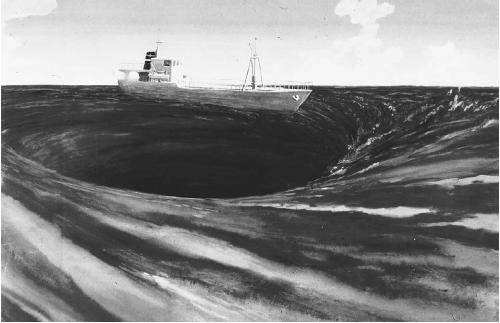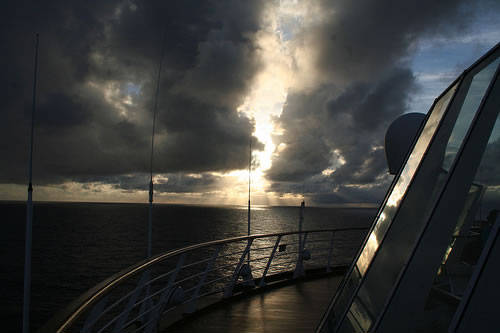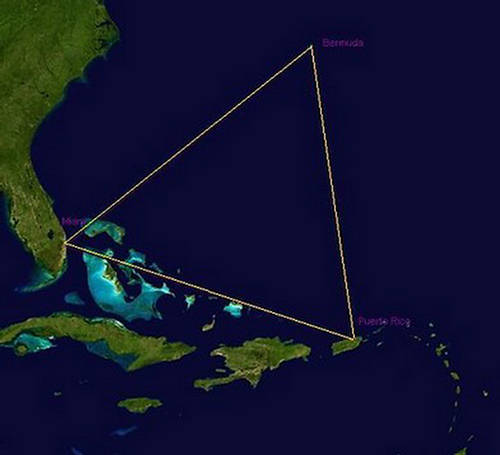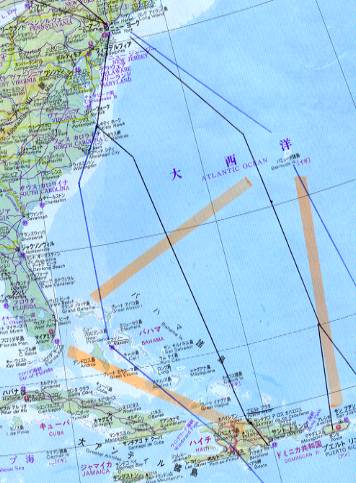
Bermuda Triangle, region of the western Atlantic Ocean that has become associated in the popular imagination with mysterious maritime disasters. Also known as the Devil's Triangle, the triangle-shaped area covers about 1,140,000 sq km (about 440,000 sq mi) between the island of Bermuda, the coast of southern Florida, and Puerto Rico..
The sinister reputation of the Bermuda Triangle may be traceable to reports made in the late 15th century by navigator Christopher Columbus concerning the Sargasso Sea, in which floating masses of gulfweed were regarded as uncanny and perilous by early sailors; others date the notoriety of the area to the mid-19th century, when a number of reports were made of unexplained disappearances and mysteriously abandoned ships. The earliest recorded disappearance of a United States vessel in the area occurred in March 1918, when the USS Cyclops vanished.
The incident that consolidated the reputation of the Bermuda Triangle was the disappearance in December 1945 of Flight 19, a training squadron of five U.S. Navy torpedo bombers. The squadron left Fort Lauderdale, Florida, with 14 crewmen and disappeared after radioing a series of distress messages; a seaplane sent in search of the squadron also disappeared. Aircraft that have disappeared in the area since this incident include a DC-3 carrying 27 passengers in 1948 and a C-124 Globemaster with 53 passengers in 1951. Among the ships that have disappeared was the tankership Marine Sulphur Queen, which vanished with 39 men aboard in 1963.
Books, articles, and television broadcasts investigating the Bermuda Triangle emphasize that, in the case of most of the disappearances, the weather was favorable, the disappearances occurred in daylight after a sudden break in radio contact, and the vessels vanished without a trace. However, skeptics point out that many supposed mysteries result from careless or biased consideration of data. For example, some losses attributed to the Bermuda Triangle actually occurred outside the area of the triangle in inclement weather conditions or in darkness, and some can be traced to known mechanical problems or inadequate equipment. In the case of Flight 19, for example, the squadron commander was relatively nexperienced, a compass was faulty, the squadron failed to follow instructions, and the aircraft were operating under conditions of deteriorating weather and visibility and with a low fuel supply. ther proposed explanations for disappearances in the Bermuda Triangle include the action of physical forces unknown to science, a "hole in the sky," an unusual chemical component in the region's seawater, and abduction by extraterrestrial beings.
Scientific evaluations of the Bermuda Triangle have concluded that the number of disappearances in the region is not abnormal and that most of the disappearances have logical xplanations. Paranormal associations with the Bermuda Triangle persist in the public mind, however.

You won't find it on any official map and you won't know when you cross the line, but according to some people, the Bermuda Triangle is a very real place where dozen of ships, planes and people have disappeared with no good explanation. Since a magazine first coined the phrase "Bermuda Triangle" in 1964, the mystery has continued to attract attention. When you dig deeper into most cases, though, they're much less mysterious. Either they were never in the area to begin with, they were actually found, or there's a reasonable explanation for their disappearance.

Does this mean there's nothing to the claims of so many who have had odd experiences in the Bermuda Triangle? Not necessarily. Scientists have documented deviations from the norm in the area and have found some interesting formations on the seafloor within the Bermuda Triangle's boundaries. So, for those who like to believe in it, there is plenty fuel for the fire.
In this article, we'll look at the facts surrounding what we do know about the area as well as some of the most commonly-recited stories. We'll also explore the bizarre theories like aliens and space portals as well as the mundane explanations.
Many think of the Bermuda Triangle, also known as the Devil's Triangle, as an "imaginary" area. The U. S. Board of Geographic Names does not recognize the Bermuda Triangle and does not maintain an official file on it. However, within this imaginary area, many real vessels and the people aboard them have seemingly disappeared without explanation.
The Bermuda Triangle is located off the Southeastern coast of the United States in the Atlantic Ocean, with its apexes in the vicinities of Bermuda, Miami, Florida, and San Juan, Puerto Rico. It covers roughly 500,000 square miles.
The area may have been named after its Bermuda apex since Bermuda was once known as the "Isle of Devils." Treacherous reefs that have ensnared ships sailing too close to its shores surround Bermuda, and there are hundreds of shipwrecks in the waters that surround it.
The Devils' Sea
Miyake Island, Japan

The Devil's Sea, also called the Formosa Triangle, is located off the coast of Japan in a region of the Pacific around Miyake Island, about 110 miles south of Tokyo. Like the Bermuda Triangle, the Devil's Sea doesn't appear on any official maps, but the name is used by Japanese fishermen. The area is known for strange disappearances of ships and planes - at least by those in the United States.
Another myth is that, like the Bermuda Triangle, the Devil's Sea is the only other area where a compass points to true north rather than magnetic north (more about this later).
One popular theory is that volcanic activity around the area, particularly an underwater volcano, could be responsible for the disappearances.
The Bermuda Triangle Mystery
Over the past 100 years, the Bermuda Triangle has seen what some say is a significant and inordinately high number of unexplained disappearances of planes, ships and people. Some reports say that as many as 100 ships and planes have been reported missing in the area and more than 1,000 lives have been lost. The U.S. Coast Guard, however, maintains that the area does not have an unusual number of incidents.
In 1975, Mary Margaret Fuller, editor of "Fate" magazine, contacted Lloyd's of London for statistics on insurance payoffs for incidents occurring within the Bermuda Triangle's usually accepted boundaries. According to Lloyd's records, 428 vessels were reported missing throughout the world between 1955 and 1975, and th*ere was no greater incidence of events occurring in the Bermuda Triangle than anywhere else in the world.
Gian J. Quasar, author of "Into the Bermuda Triangle: Pursuing the Truth Behind the World's Greatest Mystery" and curator of Bermuda-triangle.org, argues that this report "is completely false." Quasar reasons that because Lloyd's does not insure small crafts like yachts and often doesn't insure small charter boats or private aircraft, its records can't be the definitive source. He also states that the Coast Guard's records, which it publishes annually, do not include "missing vessels." He requested data on "overdue vessels" and received (after 12 years of asking) records of 300 missing/overdue vessels for the previous two years. Whether those vessels ultimately returned is unknown. His Web site has a list of these vessels.
The National Transportation and Safety Board (NTSB) database indicates (according to Gian J. Quasar) that only a handful of aircraft have disappeared off the New England coast over the past 10 years, while over 30 have occurred in the Bermuda Triangle.
The mystery of the Triangle probably took hold with the first well-publicized disappearance in 1945, when five Navy Avengers disappeared in the area. The cause of the disappearance was originally "pilot error," but family members of the pilot leading the mission couldn't accept that he had made such a mistake. Eventually they convinced the Navy to change it to "causes or reasons unknown."
Is Insurance Higher in the Bermuda Triangle?
According to Norman Hooke, who conducted marine casualty studies for Lloyd's Maritime Information Services, based in London, "The Bermuda Triangle does not exist." He instead says that disappearances in the Triangle are typically weather-related. So despite the theories of why ships and planes disappear in the area, insurance premiums are no higher than for any other area of the ocean.
The myth gained momentum after reporter E.V.W. Jones compiled a list of "mysterious disappearances" of ships and planes between the Florida coast and Bermuda. Two years later, George X. Sand wrote an article for "Fate" magazine, titled "Sea Mystery at our Back Door." The article was about a "series of strange marine disappearances, each leaving no trace whatever, that have taken place in the past few years" in a "watery triangle bounded roughly by Florida, Bermuda and Puerto Rico."
As more incidents occurred, the reputation grew and past events were reanalyzed and added to the legend. In 1964, "Argosy Magazine" gave the triangle its name in an article titled "The Deadly Bermuda Triangle" by Vincent Gaddis. Argosy magazine's tagline a "magazine of master fiction," but that did nothing to halt the spread of the myth. More articles, books, and movies have appeared, suggesting theories ranging from alien abductions to a giant octopus.
Plausible Theories about it
Most rational explanations for the incidents in the Bermuda Triangle, including the explanations given by the U.S. Navy and Coast Guard, include human error and environmental effects. The area is one of the most highly trafficked for amateur pilots and sailors, so more traffic leads to more accidents and disappearances.
Weather Patterns and Topography
The area is subject to violent and unexpected storms and weather changes. These short but intense storms can build up quickly, dissipate quickly, and go undetected by satellite surveillance. Waterspouts that could easily destroy a passing plane or ship are also not uncommon. A waterspout is simply a tornado at sea that pulls water from the ocean surface thousands of feet into the sky. Other possible environmental effects include underwater earthquakes, as scientists have found a great deal of seismic activity in the area. Scientists have also spotted freak waves up to 100 feet high.

Sea surface roughness in the Gulf Stream, captured by NASA's Terra satellite on April 18, 2004.
The underwater topography of the area may also be a factor. It goes from a gently sloping continental shelf to an extremely deep drop-off. In fact, some of the deepest trenches in the world are found in the area of the Bermuda Triangle. Ships or planes that sink into these deep trenches will probably never be found.
The Gulf Stream, where the Triangle is located, is extremely swift and turbulent. It can pose extreme navigational challenges, especially for inexperienced sailors. The Gulf Stream has been reported to move faster than 5 mph in some areas - more than fast enough to throw sailors hundreds of miles off course if they don't compensate correctly for the current. It can also quickly erase any evidence of a disaster.
Methane Gas Hydrates
This theory appears to hold promise for at least some of the disappearances in the Bermuda Triangle. Scientists at Cardiff University have discovered the presence of large concentrations of methane gas trapped in the ocean floor. This gas is due to dying and decomposing sea organisms. The sediment contains bacteria that produce methane, which accumulates as super concentrated methane ice, called gas hydrates. The layer of ice traps the methane gas, and scientists are studying it as a potential energy source.

Crystalline methane hydrate deposits
Within seconds of a methane gas pocket rupturing, the gas surges up and erupts on the surface without warning. If a ship is in the area of the blowout, the water beneath it would suddenly become much less dense. The vessel could sink and sediment could quickly cover it as it settles onto the sea floor. Even planes flying overhead could catch fire during such a blowout. Although he doesn't agree with the methane hydrate theory as an explanation for the Bermuda Triangle, Bill Dillon, a research geologist with the United States Geological Survey said that, "On several occasions, oil drilling rigs have sunk as the result of [methane] gas escape."
Pirates
While historical pirates like Blackbeard or the fictional Captain Jack Sparrow of "Pirates of the Caribbean" may not be likely candidates for disappearances, modern pirates might be. In the 1970s and '80s, drug runners often pirated boats to smuggle drugs. This theory could also bear some truth during wartime. Check out How Pirates Work for more information about piracy and real-life pirates.

The U.S.S. Winston S. Churchill follows a suspected pirate vessel in 2006.
Although these theories (among others) probably account for disappearances in the area known as the Bermuda Triangle, many people still prefer to believe that aliens, electronic fog or another supernatural phenomenon must be the cause. As long as those theories exist, the Bermuda Triangle will remain a source of fascination and mystery.

Bermuda Triangle: The Devil's Sea - Unsolved Mystery
The Bermuda Triangle, or Devil’s Triangle, is the name given to an area that has been at the center of many unexplained disappearances. The Bermuda Triangle lies between Bermuda, Miami and San Juan, Puerto Rico. Within this area of water, numerous planes and ships have mysteriously vanished.

The mystery of the Bermuda Triangle began in 1950. A small article appeared outlining the strange disappearances of ships and planes. The area was given the name The Devil’s Sea. In a feature in 1964, Vincent Gaddis christened the area the Bermuda Triangle.
One of the most famous disappearances occurred in 1945. Flight 19 was a squadron of five naval bombers. All five planes supposedly disappeared while flying over the Bermuda Triangle. The two planes that set out to rescue Flight 19 also disappeared and were never found. Naval ships such as the USS Cyclops and the Marine Sulpher Queen also disappeared without a trace.

Another disappearance was that of Donald Crowhurst, who was attempting an around the world voyage. A large ship carrying ore also mysteriously vanished after only three days at sea. An official statement by the US Coastguard states that repeated search attempts were made, but no traces were ever found of the missing planes or ships.
Popularity of the Bermuda Triangle phenomenon reached a peak in 1974 with the publication of Charles Berlitz’s book, The Bermuda Triangle. At around the same time, a film with the same name was also released. Numerous articles and books have since been published to try and give scientific explanations to the mystery. Some of the explanations have been more than credible.

The stretch of water where the disappearances occurred is notorious for tropical storms. Many of the reports at the time claim that the ships and planes were lost in calm waters. Weather reports checked since do not agree with these reports. Also, the area of water under the triangle has large areas of methane gas eruptions. These eruptions create areas of gas that are incapable of supporting the weight of a ship.
Lawrence Kusche, a reference librarian at Arizona State University, conducted a lengthy investigation into the mystery. His conclusions cast doubt on many of the disappearances. David Crowhurst’s diaries prove his mental state to be suicidal as he sailed around the world. An area of the sea off of Japan has the same strange magnetic elements as that of the Bermuda Triangle. Many disappearances have also occurred there.

There are also a number of discrepancies in the reports of the Flight 19 disappearance. Flight 19 was reported to have been manned by experienced pilots flying in calm weather. In fact, the flight was a training exercise for students and the weather had turned stormy. The last contact with the flight stated that they were running low on fuel. The flight would no doubt have crash-landed, and no one could have survived the stormy seas of the triangle.
For all Kusche’s credible explanations of the disappearances, one mystery remains. None of the crashed planes were ever recovered. As a mystery, the Bermuda Triangle is one that may never be solved. It is certainly an area that would give cause for concern to anyone traveling across.

Bermuda Triangle
The infamous ‘Bermuda Triangle’ is a region located in the northwestern Atlantic Ocean. It is one of the two places on earth where a compass will not point to true, magnetic north. A lot of people hold that the laws of physics do not apply here! Over the course of several years, Bermuda Triangle has devoured so many aircrafts and ships passing through it that it has come to be called the ‘Devil’s Triangle’.
A lot has been said and written about it. Numerous documentaries attempting to investigate the Bermuda Triangle have been made and screened. What resulted as consequence is a mix of facts, theories, mysteries and myths associated with the infamous Bermuda Triangle. But, never one solid consistent explanation! So read to apprise yourself about different aspects of the Bermuda Triangle.
Bermuda Triangle Interesting Facts
Location - The Bermuda Triangle or the Devil’s Triangle is located around the east coast of Florida and Peurto Rico. A little portion of this triangle also spills into the area next to South Carolina.
Absolute Location – Spread over a huge body of water in the Atlantic Ocean, the Bermuda Triangle does not possess a definite absolute location. But it can be said to lie in-between 80-90 degrees west and 30-20 degrees north.
Bermuda Triangle is infamous For - Over 66 airplanes and ships passing through the Bermuda Triangle have been known to have got sucked into down forever. No information was derived about them. The most notorious disappearance was that of an airplane by the name ‘Flight 19’. It disappeared some 30 years ago and has not been seen since.
Description - The Bermuda Triangle is a windy, but sunny region. Winds blowing over the region have a speed of around 10 miles m.p.h. The region does not have distinct seasons.
Bermuda Triangle Mystery & Myths
More than a 100 separate mysterious disappearances of aircrafts and ships are known to have occurred in the Bermuda Triangle region. Some really gigantic vessels like the USS Cyclops and the SS Marine Sulphur Queen have got lost in it.
Famous Italian explorer, Christopher Columbus jotted down many gripping recordings in his dairy during his journey of the Devil's Triangle in 1492. He mentioned about weird magnetic deviances in his navigation instruments. Unusual lights were noticed on the horizon. The Italian explorer has also talked about a ‘great flame of fire’ in his writings that crashed into the ocean.
A mysterious episode took place in 1872. A vessel ‘Mary Celeste’ had left for Genoa on 7 November 1872. On 4 December 1872, the crew on the Dei Gratia spotted this vessel and was alarmed by how randomly it was sailing. When they approached the ship, they found it entirely vacant. Even the lifeboat was not to be found despite the fact that the ship was otherwise in perfect condition.
The vanishing of Flight 19 tops the Bermuda Triangle collection of myths and mysteries. On 5 December 1945, five Navy Avengers went missing while on a standard training mission in the Atlantic. The patrol leader, Lt. Charles Taylor had radioed Florida the following strange message - "Control tower this is an emergency. We seem to be off course. We seem to be lost. We can't make out where we are". When instructed to turn the ship towards the west, he replied "Everything looks wrong, even the ocean looks strange". A Navy search was set out into the Atlantic that went on for weeks, but no trace was ever found of the aircraft or crew. The search team included a Martin Mariner, which blew up just after 23 minutes into its flight.
On 27 December 1948, a commercial flight flying from Puerto Rico towards Florida met with a similar fate. NC-16002 DC-3 radioed Miami that they were 50 miles out and all set to accept landing instructions. After Miami radioed back the instructions, it waited for a reply of confirmation but none came. After three hours, a search and rescue team was dispatched to trace the missing aircraft. No trace, what so ever, was found!
Bermuda Triangle Theories
A lot of authors, who have written on the Bermuda Triangle, have put forward supernatural theories to explain the disappearance of various ships and places in this region.
One such explanation theory for Bermuda Triangle episode puts blame on leftover technology from the lost continent of Atlantis. At times the submerged rock formation called ‘Bimini Road’ off the island of Bimini in the Bahamas is linked to the Atlantis story. The Bimini Road is believed to exist within the Bermuda Triangle as per some theories.
There are other writers about the Bermuda Triangle who associate the events to UFOs. This idea was used in the Hollywood film ‘Close Encounters of the Third Kind’ by famous director Steven Spielberg. It features the lost ‘Flight 19’ as being abducted by the aliens.
Charles Berlitz, the grandson of an illustrious linguist and author of many additional books on anomalous phenomena, too has commented on these extraordinary events. He has explained the losses in the Devil’s Triangle to anomalous or unexplained forces.



































